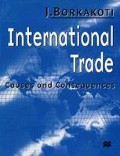Abstract
The Ricardo-Viner model,1 more commonly known as the specific-factor model, is a somewhat more realistic variant of the HOS model. It retains all the assumptions of the standard HOS model except that one factor, usually capital, is assumed to be sector-specific (at least in the short run) while labour is assumed to be perfectly mobile between the sectors. Jones (1971), Mussa (1974), Mayer (1974) and Neary (1978) have made significant contributions. Specifically, Jones (1971) has analysed some comparative static properties of the short-run Ricardo-Viner model. Neary (1978) has analysed some long-run dynamic properties when capital, the specific factor, moves from one sector to the other in response to higher rental through a process of decreasing capital stock in one sector via capital depreciation coupled with starvation of new investment and increasing capital stock in the other sector via new investment. Such an analytical framework has more relevance to the problems of the real world. If, as a result of international trade, a country produces, say, more of motor vehicles but less of textiles, then clearly capital equipment producing textiles cannot be used to produce more cars. This transformation has to take place over time as described above.
Preview
Unable to display preview. Download preview PDF.
Author information
Authors and Affiliations
Copyright information
© 1998 Jitendralal Borkakoti
About this chapter
Cite this chapter
Borkakoti, J. (1998). The Ricardo-Viner Model. In: International Trade: Causes and Consequences. Palgrave, London. https://doi.org/10.1007/978-1-349-27014-9_12
Download citation
DOI: https://doi.org/10.1007/978-1-349-27014-9_12
Publisher Name: Palgrave, London
Print ISBN: 978-0-333-72556-6
Online ISBN: 978-1-349-27014-9
eBook Packages: Palgrave Business & Management CollectionBusiness and Management (R0)

